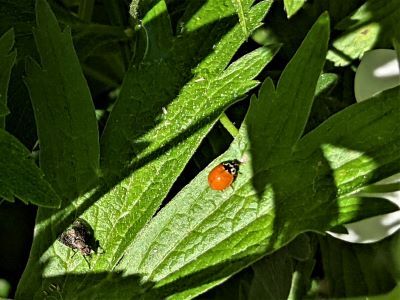
Good Natured Column: Let's Talk Ladybugs!
Living with three dogs, I've come to accept that few areas of my life will ever truly be spotless. Cattle dog Joey, who can never be too close or surveil too much, will always decorate my glasses and windows with smeary but well-intentioned nose prints. Little mutt Kit, with her adorable underbite, will always leave drips on the floor by the water dish. And the baby, Boeker, loves mud too much to let it stay outside.
So you can imagine the delight I experienced the other day when, walking in the native plant garden behind the Pottawatomie Community Center in St. Charles, I spotted an insect so very spotless that I had to stop and take a second, and third and fourth look. It was small; it was red. It was radiating immaculate glory… It was a spotless lady beetle, Cycloneda munda. I couldn't believe my eyes. A native lady bug! Could it really be??
If you're like me, you've probably come to accept that virtually every ladybug you see is a nonnative multicolored Asian lady beetle, Harmonia axyridis. You know the ones I'm talking about: Fairly large, for a ladybug, with a peculiar smell and a reputation for biting. They also have a tendency, in fall, to underscore their pest status by amassing on windowsills and other indoor areas as they seek shelter from the coming cold.
Though not quite as common in our area, we also have a considerable number of seven-spotted lady beetles, Coccinella septempunctata, flitting about. They, too, compete with our indigenous species for food and habitat.
That our native ladybugs are declining is not in dispute; the reasons, though, have yet to be pinned down. Besides the introduced species, the iconic lady beetles (more than 500 species call North America home) face threats from climate change, habitat degradation and pesticide use.
The upshot is, a native ladybug is worth noting.
The species I was lucky enough to spot caught my eye not because it was large and conspicuous, but rather small and somewhat elusive. Little C. munda, which also goes by the common names polished, no-spotted and immaculate lady beetle, is just over 1/8-in. long; the MALB, by comparison, can be as large as 1/3 inch.
It was scrambling about on a stem of Canada anemone, no doubt looking for the soft-bodied insects that make up the bulk of its diet. Its pronotum, which is the plate that covers the head and thorax, was dark with white markings that extended to the sides and ended with two nearly-closed C shapes. Oh and did I mention its red elytra, or wing covers, were spotless?
As I was observing the lady beetle and trying to determine if it was indeed an actual native species, a fly landed nearby and started what I like to think of as handwashing—rubbing first its forelegs, then its hindlegs together as a means of cleaning off whatever debris its little fly feet had acquired. The lady beetle, immaculate as it was, saw no need to engage in such behavior and quickly scurried to the underside of the leaf.
I tried to follow it down the stem of the plant but soon lost it amid the shadows of the thick greenery. But the image of its tiny self, along with the few photos I was able to snap, will be with me for a long time to come.
In seeking to identify the insect, I came across a community-science effort worth mentioning: The Lost Ladybug Project. Founded by John Losey, an associate professor of entomology at Cornell University, the program seeks to find out “where all the ladybugs have gone so we can try to prevent more native species from becoming so rare."
Though geared toward kids, the project's data set is impressive—more than 39,000 photo submissions so far—and its ID tools are helpful. In addition its website, www.lostladybug.org, includes many pages with helpful descriptions and photos as well as links to other websites dedicated to conservation.
Of particular note is the LLP webpage titled, “Are you a nine-spotted ladybug?" Coccinella novemnotata was once widely distributed across the United States, but declined precipitously in the 1970s and '80s. Though not on the federal endangered species list, C-9, as it's been dubbed, is considered imperiled and effectively extirpated from the eastern United States.
Ladybugs—or the lack of—is also the subject of a project on another great online database, iNaturalist (www.inaturalist.org). The Ladybird Beetles "Ladybugs" of the Midwest project is actively seeking observations from the U.S. region that includes Illinois and 11 other states plus southern Ontario, Canada. To date this effort has collected nearly 35,000 records; of these, 15 are nine-spotted ladybugs.
For some perspective, more than 17,000 of this project's observations are MALBs; the European seven-spotted ranks third with 3,600+ records. And little C. munda, the spotless lady, ranks fourth with around 1,300 sightings.
Determining the status of our native lady beetle species is one of the first steps toward starting to help them. Maybe it's time to head out and “spot" some yourself!
Pam Otto is the outreach ambassador for the St. Charles Park District. She can be reached at 630-513-4346 or potto@stcparks.org

